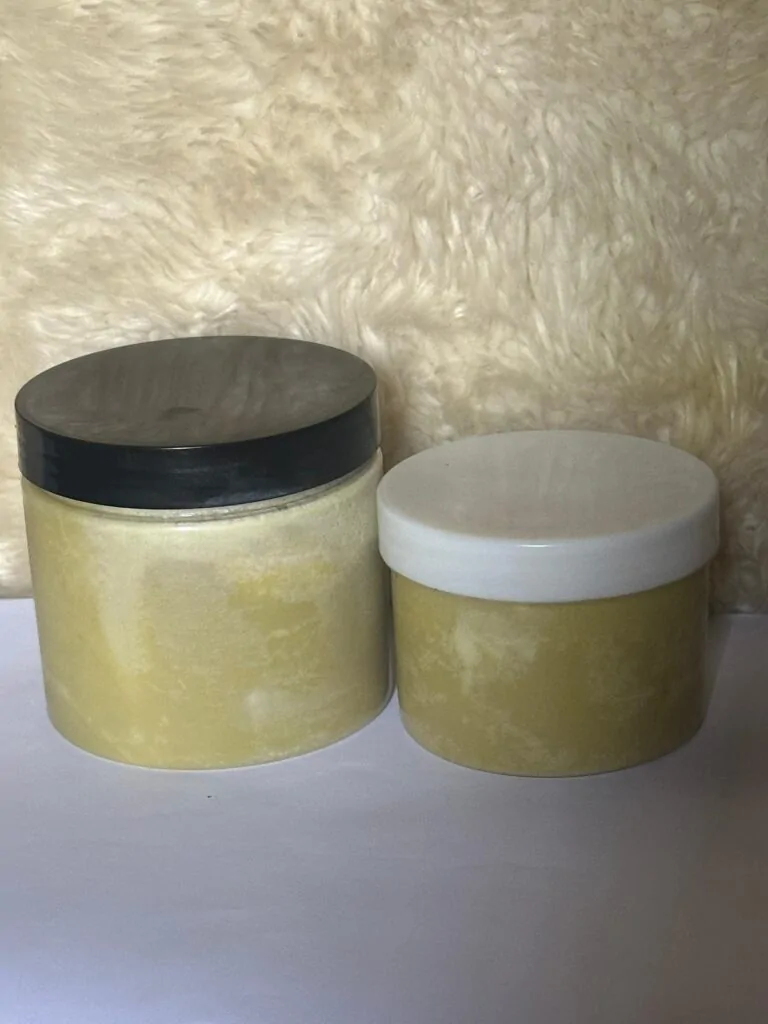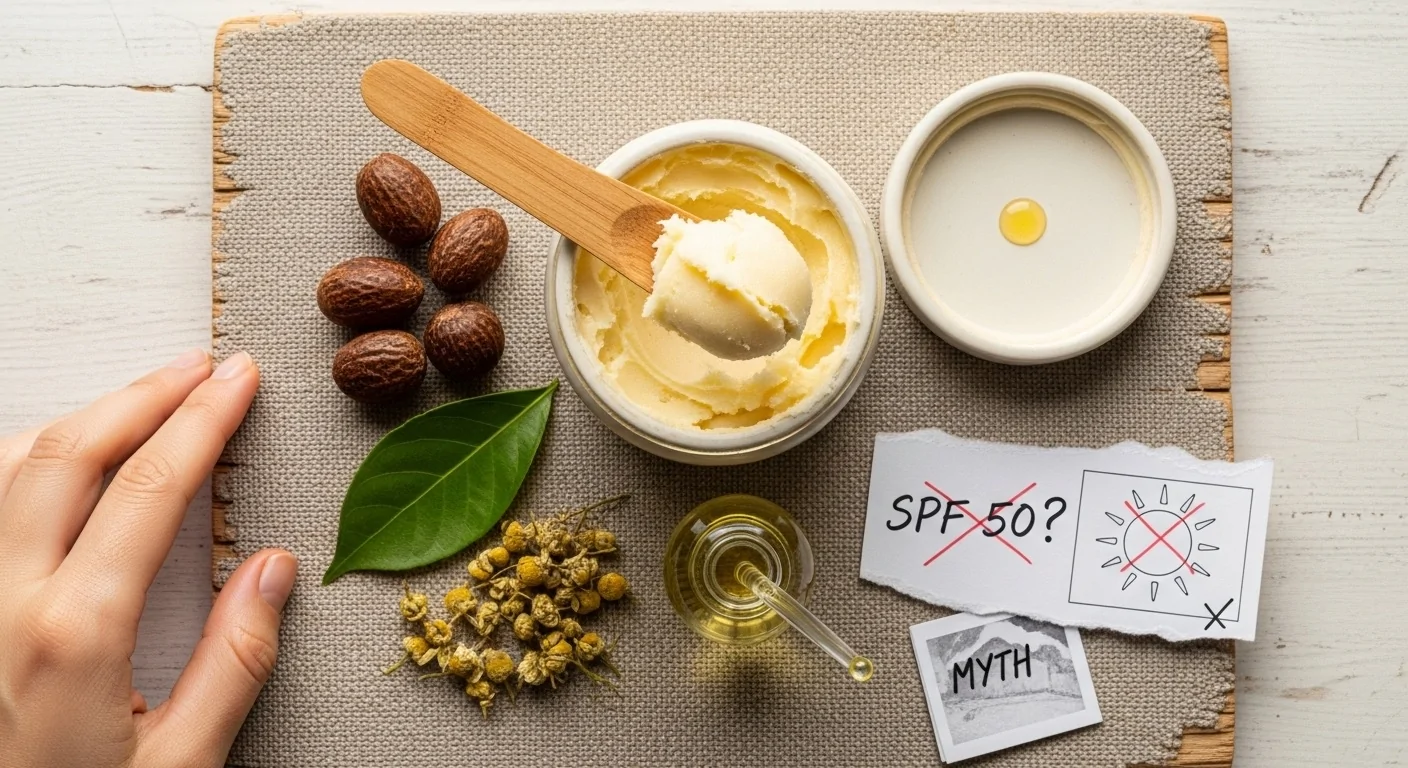Shea Butter Benefits and What’s NOT True
Pure shea butter is one of Africa’s most treasured beauty secrets, but separating fact from fiction can be challenging. While this natural moisturizer delivers real, scientifically-proven benefits for skin and hair, countless myths circulate online about its capabilities. This guide reveals what raw shea butter actually does—and debunks the most common misconceptions that could be setting you up for disappointment.
Table of Contents
Shea butter (extracted from the nuts of West Africa’s Vitellaria paradoxa tree) contains a powerful combination of fatty acids, vitamins, and anti-inflammatory compounds that have been clinically studied. But it cannot lighten your skin, replace your sunscreen, or grow your hair faster. Understanding the truth helps you use this incredible African ingredient effectively while managing realistic expectations.
What Makes African Shea Butter Special?

Unrefined shea butter isn’t just another moisturizer—its unique composition sets it apart. The nutrient-rich butter contains 85-90% fatty acids, primarily oleic acid (40-60%) and stearic acid (20-50%), which create an effective moisture barrier on skin. What makes it exceptional is the 4-19.8% unsaponifiable matter—significantly higher than most plant oils—packed with triterpene alcohols, vitamins A and E, and phenolic compounds including gallic acid and catechins.
This composition explains why pure African shea butter has been used for centuries throughout Ghana, Nigeria, Mali, and Burkina Faso. The anti-inflammatory compounds work at a cellular level: a 2012 study in the Journal of Complementary and Integrative Medicine demonstrated that shea butter extract significantly reduced inflammatory markers (TNF-α, IL-1β, IL-12) in a dose-dependent manner by suppressing the NF-κB pathway. These aren’t just marketing claims—they’re measurable biological effects.
The difference between refined and unrefined shea butter is dramatic. Processing with high heat and chemical solvents destroys up to 75% of bioactive ingredients, including the crucial cinnamic acid that provides anti-inflammatory benefits. When shopping for raw shea butter or pure shea butter, choose unrefined varieties with that characteristic nutty, slightly smoky scent—it signals intact nutrients.
Scientifically Proven Benefits You Can Trust
Eczema and dermatitis relief stands out as shea butter’s most impressive validated benefit. A 2009 study published in the Journal of Allergy and Clinical Immunology compared shea butter to petroleum-based products using a 0-5 severity scale. Shea butter reduced symptoms from level 3 to level 1, while Vaseline only improved from 3 to 2. A pediatric study of 34 children with atopic dermatitis found 74% rated the shea butter treatment as “very good” or “good,” with significant improvements in itching and quality of life after just 4 weeks.
The moisture barrier repair happens remarkably fast. Clinical trials show that within 2 hours of application, shea butter helps skin completely recover from transepidermal water loss (TEWL). After 3-4 hours, skin barrier function measurably improves. The fatty acids work like natural ceramides in your epidermis, sealing in hydration that can last several hours. This makes pure shea butter particularly effective for dry skin, cracked heels, chapped lips, and dry hands.
Anti-inflammatory properties benefit multiple skin conditions. The triterpene compounds (including lupeol, butyrospermol, and amyrin) inhibit pro-inflammatory enzymes COX-2 and iNOS while blocking inflammatory cytokines. Studies show ID50 values of 0.15-0.75 micromol/ear for reducing inflammation in animal models. Practically, this means raw shea butter can soothe redness, calm irritated skin, and provide relief for psoriasis, rosacea, and general dermatitis.
For tattoo aftercare, shea butter’s combination of deep moisturization and anti-inflammatory action makes it ideal. Many professional tattoo products now include it as a primary ingredient. The vitamins A and E support skin regeneration during healing, while the non-comedogenic nature (for most people) prevents clogged pores. Apply sparingly 2-3 times daily after the initial healing period to keep colors vibrant and prevent scabbing.
What’s NOT True: The Biggest Shea Butter Myths Exposed
Myth 1: Shea butter works as sunscreen
The Reality: Shea butter has an SPF of only 3-7—nowhere near adequate sun protection. The FDA requires minimum SPF 15 for any sunscreen claim, and dermatologists recommend SPF 30+ for daily use. While shea butter contains cinnamate esters that absorb some UVB radiation (250-300nm wavelength), this provides approximately 86-77% below minimum protection standards.
Dr. Purvisha Patel, a board-certified dermatologist, states clearly: “Shea butter has an estimated SPF of 3 to 4. This is not enough sun protection for adequate UV protection to prevent hyperpigmentation, DNA damage, skin cancers, photoaging, and wrinkles.” The Cleveland Clinic confirms shea butter’s SPF is “too small to prevent sun damage or sunburn on its own.”
Interestingly, research shows shea butter can boost existing sunscreen formulations by up to 35% and enhance photostability of UV filters. A 2020 study in the Journal of Cosmetic Dermatology found that adding 15% shea butter to sunscreen ingredients increased SPF to 39.1. But alone? It cannot replace proper sun protection. Use unrefined shea butter for moisturizing after your shower, then apply separate SPF 30+ broad-spectrum sunscreen before sun exposure.
Myth 2: Shea butter lightens or darkens skin
The Reality: Shea butter does neither. This persistent myth stems from confusion about moisturization effects, sun exposure, and quality issues. Scientific studies actually show shea butter has melanogenesis-inhibitory properties—meaning it inhibits melanin production at the cellular level—yet this effect isn’t strong enough to change your natural skin tone in practical use.
Research by Akihisa et al. (2014-2015) published in Phytochemistry demonstrated that triterpene compounds from shea butter inhibit melanin production in laboratory cell studies. However, this doesn’t translate to visible skin lightening in real-world application. Shea butter contains no bleaching agents and cannot alter your natural melanin production.
The “darkening” myth typically occurs when people apply shea butter without sunscreen, then spend time in the sun. The oil on skin plus UV exposure enhances tanning—but the culprit is sun exposure, not the shea butter itself. Low-quality products with impurities (latex residue, smoke particles) can temporarily stain skin, which gets wrongly blamed on shea butter generally.
What shea butter actually does is make skin appear more radiant and even-toned through optimal hydration. Well-moisturized skin looks healthier than dry, ashy skin—but this isn’t tone change, it’s improved skin health. For dark spots and hyperpigmentation, shea butter provides supportive benefits through cell turnover (vitamin A) and anti-inflammatory effects, but it’s not a primary treatment. Proven ingredients like vitamin C, kojic acid, and hydroquinone work far more effectively for hyperpigmentation.
Myth 3: Shea butter promotes hair growth
The Reality: Shea butter does not accelerate hair growth or stimulate hair follicles. Baraka Shea Butter’s evidence-based review states clearly: “There is no scientific evidence to suggest that shea butter directly affects hair growth. Factors such as genetics, nutrition, and hair care practices play a much larger role in hair growth.”
Dr. Azadeh Shirazi, a board-certified dermatologist, confirms: “There’s little research to support shea butter in stimulating hair growth. However, shea butter does help strengthen the hair shaft and reduce hair breakage, which in turn helps with healthier hair that may grow better and longer.”
The confusion stems from conflating hair health with growth promotion. Shea butter creates a healthier scalp environment through moisturization and anti-inflammatory properties, and it prevents breakage and split ends through conditioning. This helps you retain length, creating the appearance of faster growth. But the actual growth rate from follicles remains unchanged. Your hair grows at its genetically predetermined rate—approximately 0.5 inches per month for most people—regardless of shea butter use.
The same applies to beard growth. While shea butter conditions beard hair, softens the skin underneath, and reduces irritation and ingrown hairs, it doesn’t stimulate faster or thicker beard growth.
Myth 4: Other false claims to ignore
Breast enlargement: Completely false. Typology.com (2023) confirms: “No scientific study has shown any capacity of shea butter to enlarge the buttocks or another body area, such as the chest.” Fatty acids do not cause tissue growth. Any temporary “firmness” is simply skin tightening from moisturization.
Cough treatment: Partially misleading. While hospital studies in Nigeria show shea butter extracts work effectively as nasal decongestants (within 30 seconds to 1 minute), this isn’t the same as treating coughs directly. It’s applied to/inside the nose for congestion relief, not consumed or applied to the chest as some folk remedies suggest.
Cellulite reduction: No scientific evidence supports this claim. Temporary skin-plumping from moisturization may create a visual effect, but shea butter doesn’t reduce actual cellulite deposits.
The Best Ways to Use Pure Shea Butter
For face: Raw shea butter works beautifully for dry and combination skin when applied sparingly at night. Apply to damp skin after cleansing to seal in moisture. However, those with oily or acne-prone skin should exercise caution—while rated non-comedogenic by many sources (0-2 on the comedogenic scale), the American Academy of Dermatology warns it can clog pores in some individuals. Always patch test first.
For body: Apply within minutes of showering while skin is still slightly damp. This seals in water and creates a long-lasting moisture barrier. Unrefined shea butter melts at body temperature (approximately 37°C), allowing smooth absorption without greasiness when applied correctly. Focus on dry areas like elbows, knees, and cracked heels.
For lips: Shea butter’s vitamin K prevents bleeding from cracks, while vitamins E and F seal in moisture and lubricate. Apply as needed throughout the day, especially in cold or dry climates. It’s safe for the delicate lip skin and can serve as a base before lipstick.
For specific conditions: Use consistently for eczema (2-3 times daily), apply generously to cracked heels overnight with cotton socks, massage into nails and cuticles to strengthen and prevent hangnails, and use as tattoo aftercare after initial healing to maintain vibrancy.
Where to Buy Quality Shea Butter in Bulk in Nigeria
Finding authentic, pure African shea butter matters tremendously for getting real benefits. When looking to buy shea butter in bulk in Nigeria, African Things offers genuine unrefined shea butter sourced directly from West African producers. Based in Lagos, we specialize in authentic African-inspired gifts and natural products, including raw shea butter that retains the full 100% of bioactive compounds lost in refined versions.
WhatsApp UsQuality indicators include: ivory to light yellow color (not pure white), natural nutty/earthy scent (not odorless), and slightly grainy texture when solid. Avoid products labeled simply “shea butter” without specifying unrefined or raw—these are likely refined versions with dramatically reduced benefits.
The Bottom Line on Shea Butter Benefits
Pure shea butter delivers legitimate, scientifically-validated benefits as an intensive moisturizer, anti-inflammatory treatment, and skin barrier protector. Clinical studies confirm its effectiveness for eczema, dermatitis, dry skin, chapped lips, and general skin health. The 40-60% oleic acid content, combined with vitamins A and E and unique triterpene compounds, creates measurable biological effects that support skin healing and protection.
But managing expectations is crucial. Shea butter cannot replace sunscreen, lighten or darken your skin tone, grow your hair faster, or enlarge body parts. These myths persist through marketing hype, misunderstanding moisturization effects, and conflating different concepts. When you understand what African shea butter actually does—and what it doesn’t—you can incorporate this incredible natural ingredient effectively into your skincare routine.
Choose unrefined shea butter for maximum benefits, apply it consistently, always use separate sunscreen for sun protection, and give it time to work (most benefits appear after 2-4 weeks of regular use). African traditions have treasured this gift from the shea tree for centuries—now you know how to use it based on science, not myths.
FAQs: Your Shea Butter Questions Answered
Can shea butter be used as a sunscreen?
No. Shea butter alone is not a sunscreen. It has a very low natural SPF of 3-7, which is far below the SPF 30 recommended by dermatologists. It cannot prevent sun damage or skin cancer on its own. Always use a separate broad-spectrum SPF 30+ sunscreen. Shea butter can be used as a moisturizer before sunscreen or to soothe skin after sun exposure.
Can I use shea butter on my face?
Yes, shea butter can be an excellent facial moisturizer, especially for dry, mature, or sensitive skin. Raw (unrefined) shea butter is the best choice as it retains 100% of its beneficial compounds (like vitamins A and E) for anti-inflammatory and antioxidant benefits. Apply sparingly to clean, damp skin. Those with oily or acne-prone skin should use caution, as it may clog pores in some individuals despite its non-comedogenic rating.
Can I apply shea butter on my face at night?
Yes, overnight application works well for dry skin. Apply sparingly before bed so it can penetrate deeply while you sleep. However, using too much can leave greasy residue on pillows. Start with a pea-sized amount for the entire face.
Does shea butter lighten or darken skin?
No, shea butter does not lighten or darken skin. It does not contain any bleaching agents to lighten skin, nor does it have properties that darken it. This myth typically occurs when people apply shea butter without sunscreen and then get sun exposure—the UV rays cause tanning, not the shea butter.
Is shea butter good for dark spots or scars?
Shea butter may modestly improve the appearance of dark spots and scars over 4-6 months, but it’s not a primary treatment. For dark spots, it helps indirectly via Vitamin A (cell turnover) and anti-inflammatory effects. For scars, its fatty acids soften scar tissue and its anti-inflammatory properties may reduce keloid formation. It supports healing but won’t erase scars like professional treatments.
Does shea butter grow hair?
No, shea butter does not accelerate hair growth or stimulate hair follicles. There is no scientific evidence that it affects hair growth rate. What shea butter does is improve hair health by moisturizing, conditioning, preventing breakage and split ends, and soothing scalp inflammation. This helps you retain length (preventing damage), which can create the appearance of faster growth, but the actual growth rate from follicles remains unchanged.
Can I use body butter on my hair?
Yes, body butter (including shea-based) can be used on hair, though it’s formulated for skin rather than hair. Apply to damp hair focusing on ends, not roots, to avoid greasiness. Use sparingly as it can cause buildup. Body butter works best for thick, curly, or coarse hair types. Hair-specific shea butter products are preferable as they’re formulated for proper hair absorption and texture.
What are the main benefits of shea butter for skin?
Yes, shea butter, especially raw/unrefined African shea butter, is excellent for skin. Its primary benefits are:
- Deep Moisturization: Fatty acids seal in moisture and prevent water loss
- Anti-Inflammatory: Soothes redness and irritation from conditions like eczema, dermatitis, and rashes
- Skin Barrier Repair: Helps repair a damaged skin barrier in as little as 2-4 hours
- Antioxidant & Anti-Aging: Vitamins A and E protect against free radicals and support collagen
- Healing Support: Aids in healing minor wounds and soothing sensitive skin
Is shea butter good for beards?
Shea butter is good for beard conditioning and skin health beneath the beard, but it does not promote beard growth. It:
- Moisturizes dry skin under the beard
- Reduces inflammation and itchiness
- Softens and conditions beard hair
- Prevents ingrown hairs
- Strengthens existing beard hair
However, it will not accelerate growth rate or increase beard density—beard growth is determined by genetics and hormones.
Can you use shea butter on tattoos?
Yes, shea butter is excellent for tattoo aftercare and healing. Benefits include:
- Deep moisturization that prevents scabbing
- Anti-inflammatory properties that reduce swelling and redness
- Vitamins A and E that support skin regeneration
- Color preservation
Many professional tattoo aftercare products contain shea butter. Use after the initial healing period (few days to weeks), applying sparingly 2-3 times daily.
Is shea butter good for burns?
Shea butter may help with minor burns and sunburn relief through anti-inflammatory properties and fatty acids that lock in moisture during healing. However, it’s not recommended as the sole treatment for significant burns—seek medical attention for serious burns.
Is shea butter good for oily skin?
Use with caution. Shea butter may help balance sebum production (properly moisturized skin produces less oil), but it may cause breakouts in some individuals with oily skin. Test on a small area first and apply in thin layers.
Is shea butter good for wrinkles?
Yes, shea butter has anti-aging benefits. Triterpene esters stimulate collagen production, while vitamins A and E provide antioxidant protection. Studies show regular use can reduce fine lines by plumping skin and prevent photo-aging. It works best as preventive care rather than reversing deep wrinkles.
Is shea butter good for rashes?
Yes, shea butter’s anti-inflammatory properties effectively soothe various rashes. It reduces redness, itching, and discomfort while moisturizing irritated skin. Safe for sensitive skin and suitable for diaper rash, contact dermatitis, and general skin irritation.
Is shea butter good for rosacea?
Potentially helpful. Shea butter’s anti-inflammatory properties can reduce redness and swelling associated with rosacea. Its non-comedogenic nature suits sensitive skin. However, it works best in specially formulated products rather than pure shea butter alone. Patch test first.
Is shea butter good for dermatitis?
For general dermatitis: Yes, highly effective. Anti-inflammatory properties soothe irritation while repairing damaged skin barrier. Clinically proven for atopic dermatitis (eczema).
For seborrheic dermatitis: Use with caution. The rich texture may worsen oily skin (a seborrheic dermatitis trigger). If using, choose lightweight formulations.
Is shea butter good for itchy skin?
Yes, very effective. Anti-inflammatory properties directly reduce itching, while intensive moisturization addresses itch caused by dry skin. Suitable for chronic itch conditions, eczema-related itching, and general skin irritation. Apply as needed.
Is shea butter good for cellulite?
No scientific evidence supports cellulite reduction from shea butter. Any temporary improvement is likely due to skin-plumping from moisturization creating a visual effect. Shea butter does not reduce actual cellulite deposits beneath the skin.
Is shea butter good for hemorrhoids?
Potentially helpful. A 2021 study showed shea butter used as a suppository base had anti-hemorrhoid effects. The anti-inflammatory properties reduce swelling, while the protective barrier soothes irritation. It’s used as a carrier/base ingredient rather than active treatment. Consult a healthcare provider for persistent issues.
Is shea butter good for ingrown hairs?
Potentially helpful. Anti-inflammatory properties reduce irritation and redness from ingrown hairs, while moisturizing action prevents skin tightness that contributes to them. No direct clinical studies exist, but anecdotal evidence suggests benefits.
Is shea butter good for all skin tones (e.g., black or white skin)?
Yes, shea butter is excellent for all skin tones. Its benefits are not dependent on melanin levels. For black skin, it’s traditionally used to provide deep nourishment, prevent an ashy appearance from dryness, and maintain a natural glow. For fair/white skin, it provides the same powerful moisturizing and anti-inflammatory benefits, and its antioxidants (Vitamins A & E) are excellent for helping to repair and prevent sun damage (though it is not a sunscreen).
Is shea butter good for lips?
Yes, it’s highly effective for lip care, especially for dry or chapped lips. It provides intensive moisturization, creates a protective barrier against harsh weather, and its vitamins (E, F, K) help heal cracks and keep lips soft. It can be applied as needed or as a base before lipstick.
Is shea butter good for feet?
Yes, highly effective for feet and cracked heels. Provides intensive repair of severe dryness, deep penetration to soften calluses, and smooths rough skin. For best results: apply generously before bed, wear cotton socks overnight to lock moisture, and expect visible improvement within 3 days.
Is shea butter good for hands?
Yes, excellent for daily hand care. It repairs damage from frequent washing and sanitizing, protects against harsh weather, and strengthens the skin barrier. Apply after each hand washing for maximum benefit.
Is shea butter good for nails?
Yes, very beneficial for nails and cuticles. It moisturizes nail beds, softens cuticles, strengthens nails, and prevents hangnails. Massage into nails and cuticles nightly for best results.
Is shea butter good for under eyes?
Yes, suitable with care. It can help reduce fine lines (crow’s feet) and improve skin elasticity. It’s gentle enough for the delicate eye area. Use a minimal amount and pat gently (don’t rub). Avoid getting it in your eyes.
Can I use shea butter as a daily body moisturizer or lotion?
Yes, shea butter is an excellent natural moisturizer and can replace commercial body lotion, especially for dry, sensitive, or mature skin. It melts at body temperature and provides long-lasting hydration by creating a protective barrier that seals in moisture. For best results, apply a small amount to damp skin right after bathing. It’s particularly effective on dry areas like elbows, knees, and feet.
Is shea butter good for you?
Yes, shea butter is generally safe and beneficial for most people when used topically. Allergic reactions are extremely rare (it’s not considered a tree nut allergen). It’s safe for pregnant/breastfeeding women (topical use), suitable for children 3+ years, and safe for long-term use. Consult a healthcare provider if you have specific skin conditions or concerns.
Can you use shea butter as deodorant?
Not alone. Shea butter serves as an excellent moisturizing base in natural deodorant formulations but does not control odor by itself. It’s often combined with odor-controlling ingredients like baking soda or magnesium hydroxide and moisture-absorbing ingredients like arrowroot powder. Its role is to moisturize underarm skin and prevent irritation.
Is shea butter good for breast enlargement?
No, this is completely false. No scientific study supports claims that shea butter can enlarge breasts or any other body part. Any temporary firmness is simply a skin-tightening effect from moisturization, not actual tissue growth. This is a marketing myth.
Is shea butter good for cough?
Partially true for nasal congestion, not direct cough treatment. Studies in Nigeria show shea butter extracts are effective nasal decongestants, with relief achieved quickly. In West African traditional medicine, it’s applied inside the nose for congestion relief. However, it is NOT a cough suppressant—it works by decongesting airways, which may reduce coughing related to congestion.
Benefits of black soap and shea butter
African black soap combined with shea butter provides enhanced cleansing with moisturization. Black soap deeply cleanses, removes impurities, and has antibacterial properties, while shea butter (used after) prevents over-drying, soothes irritation from the soap’s alkalinity, and provides post-cleanse moisturization. This combination is traditional in West African skincare.



